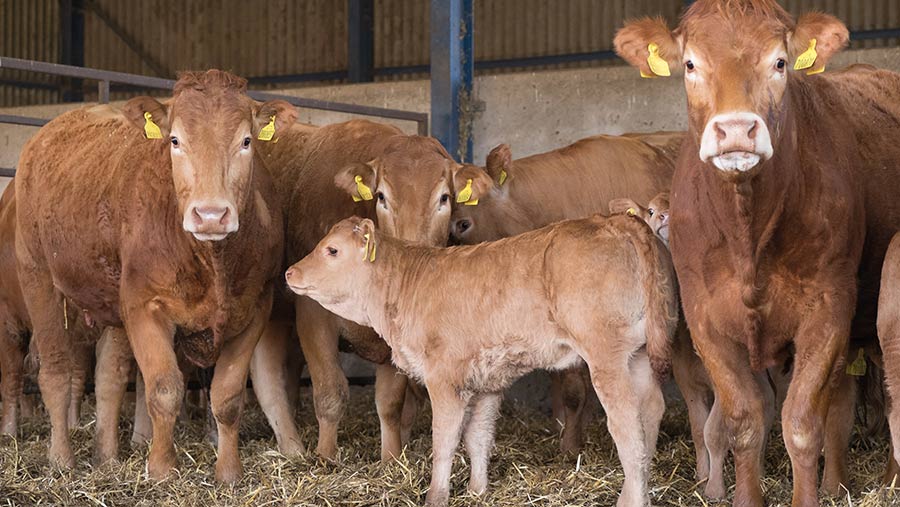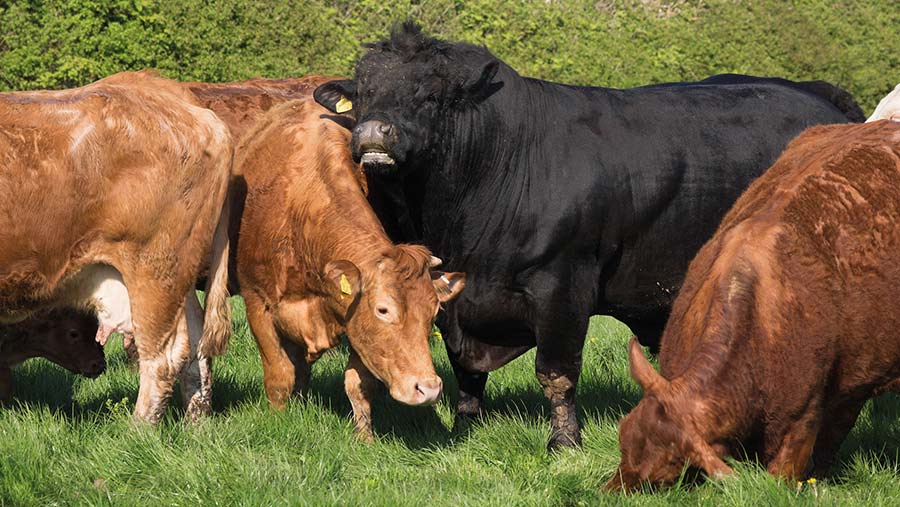Advice on managing body condition in cattle pre-calving
 © Tim Scrivener
© Tim Scrivener Weather conditions in recent years have tended to become hotter and wetter, or hotter with drought, producing variable grazing conditions around the UK.
As a result, cattle have been approaching key stages of the production cycle with too little or too much condition, risking calving difficulties, poor colostrum production and mineral deficiencies.
However, herd managers should not take drastic action to alter condition scores, according to Scotland’s Rural College (SRUC) consultant Lorna MacPherson.
See also: How to manage and minimise difficult calvings in cows
Instead, she stresses the importance of a gradual transition over a period of months.
“The transition requires careful planning and long-term management,” she says.
Overfit cows can then still lose a moderate amount of condition in a safe and managed way.
Below, Ms MacPherson and SRUC beef consultant Robert Ramsay offer advice on how to manage condition to prevent issues at calving.
Body condition scoring
Spring-calving herds
For spring herds with overfit or thin cows, the window for making big changes to condition scores should close around the start of the new year or eight weeks ahead of calving.
In regions where grass growth has been good this year, cows have become overfleshed.
But even so, Mr Ramsay advises against dramatic condition reductions.
“Starving a fat animal at this stage of pregnancy puts pressure on the unborn calf, and the cow still needs enough energy and protein to make quality colostrum,” he says.
Inadequate nutrition may leave the dam weaker just as she is facing the physical demands of calving.
It also heightens the risk of hypomagnesaemia and other deficiencies.
Holding rations, including straw or a low-quality forage such as hay, should be offered instead.
Straw-based rations need careful balancing as straw is very low in minerals, trace elements and vitamins.
Magnesium, which aids muscle function, must be provided to limit calving problems, particularly in older and overfat cows that have a lower appetite at calving.
Magnesium should also be fed if the farm produces high (more than 2.5%) potassium silages.
Aim for a supply of 25g of magnesium/day a head for normal rations, and 30-35g magnesium for high-potassium silages.
Target condition scores |
||
|
|
Spring-calving herds |
Autumn-calving herds |
|
Calving |
2.5 |
3.0 |
|
Service |
2.5-3.0 |
2.5-3.0 |
|
Housing |
3.0 |
3.0 |
|
Source: SRUC |
||
In drought-stricken areas where grass growth and forage have been limited, there are herds with a proportion of thin cows.
The temptation is to feed them a rich ration. But this also carries a risk of adding to the calf size and associated calving difficulties. Internal fat can be laid down around the birth canal, putting an even tighter constriction on the calf.
It is essential to achieve a controlled weight gain with good-quality forages and to avoid large amounts of concentrates.
Autumn-calving herds
The difficulty with autumn-calving herds is that cows are at grass up until calving and feed quality varies according to the weather.
In dry regions, cows can often be too thin ahead of housing, while in areas of high rainfall and high grass growth, cows are coming in overfit.
But the main concern with autumn calvers is that they will arrive at housing way too fat.
Where grass growth is too high, feed intakes should be managed through the growing season and restricted if necessary, providing it is not too close to calving, Mr Ramsay says.
Stocking rates can be increased, or the herd can be housed early, to control intakes.
Straw can also be introduced in ring feeders through the summer months to hold back condition.
But if cows are eating more than 5kg/day of straw at grass, other supplementary forage will be required to supply enough protein in the overall ration.
In contrast, where cows reach housing and have a condition score below 3, or where silage quality is low, sufficient energy should be added to the ration.
Managing bull condition
Bulls need to arrive at mating in good condition with a score of about 3.5.
The animal has a lot of work in front of him and he needs to be fit enough to produce a tight calving pattern, says Mr Ramsay.
If the bull is allowed to put on too much condition ahead of mating, his fertility and willingness to work can be compromised.
Likewise, too much condition loss can result in the same outcome so bull condition must be managed carefully.

© Tim Scrivener
Sellers will often push a bull hard on concentrate ahead of sale, and although this makes the animal look impressive, it is often overfit and reaches the farm in a condition score of 4.
When bulls are brought to the herd, a new feed regime should be established that safely transitions the diet into a lower-energy forage base to reduce condition gradually to a score of 3.5.
Managing condition
Key to managing cow condition is knowing forage quality and the cow’s requirements.
For example, a 700kg cow needs about 80MJ of metabolisable energy (ME) for maintenance. If she is eating a 9ME silage, she should be fine eating this to appetite without gain.
However, an 11ME silage, fed to appetite, could see her gain 0.5kg/day or more.
The relatively small change means forage should be analysed throughout the winter, particularly when there are changes in bales or cuts in the pit.
With a knowledge of forage quality, cows should be grouped according to condition at housing, which leaves time to make adjustments to rations.
Grouping on condition should always be the priority, but it may be necessary to consider early- and late-calving cattle within the herd and tailoring the ration to alter condition more gradually.
Lean cows
- If cows are too lean at this stage, continue feeding them to gain condition. But avoid overloading rations with concentrates and feed the best-quality forage available, ad-lib, to maintain rumen function.
Overfat cows
- Fat cows can safely lose weight at about 0.5kg/day, provided the protein and mineral elements of the diet are being met. For any overfit animals, delaying housing and running cattle in paddocks with limited grass is the best option to reduce condition.
First and second calvers may also need to be grouped with thinner cows because a proportion of the diet will be providing nutrition for tissue and bone growth, rather than condition.
